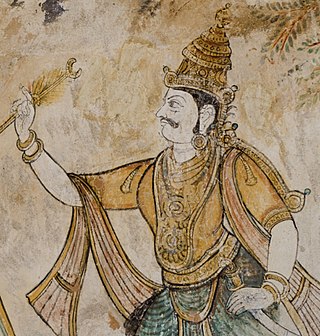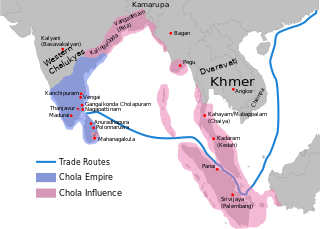
The Andaman Islands are an archipelago, made up of 200 islands, in the northeastern Indian Ocean about 130 km (81 mi) southwest off the coasts of Myanmar's Ayeyarwady Region. Together with the Nicobar Islands to their south, the Andamans serve as a maritime boundary between the Bay of Bengal to the west and the Andaman Sea to the east. Most of the islands are part of the Andaman and Nicobar Islands, a Union Territory of India, while the Coco Islands and Preparis Island are part of the Yangon Region of Myanmar.

The Andaman and Nicobar Islands is a union territory of India. It consists of 836 islands grouped into two island groups: the northern Andaman Islands and the southern Nicobar Islands, separated by a 150 km (93 mi) wide channel. Port Blair is the capital and largest city of the territory, located about 1,190 km (740 mi) from Chennai and 1,255 km (780 mi) from Kolkata in mainland India. The islands are sandwiched between the Bay of Bengal to the west and the Andaman Sea to the east with the northern-most point located 901 km (560 mi) from the mouth of Hooghly river. Indira Point at 6°45’10″N and 93°49’36″E at the southern tip of Great Nicobar is the southernmost point of India.

The Tamil people, also known as Tamilar, Tamilians, or simply Tamils, are a dravidian ethnolinguistic group who natively speak the Tamil language and trace their ancestry mainly to India's southern state of Tamil Nadu, to the union territory of Puducherry, and to Sri Lanka. The Tamil language is one of the world's longest-surviving classical languages, with over 2000 years of Tamil literature, including the Sangam poems, which were composed between 300 BCE and 300 CE. People who speak Tamil as their mother tongue and are born in Tamil clans are considered Tamils.

Srivijaya, also spelled Sri Vijaya, was a Buddhist thalassocratic empire based on the island of Sumatra that influenced much of Southeast Asia. Srivijaya was an important centre for the expansion of Buddhism from the 7th to 11th century AD. Srivijaya was the first polity to dominate much of western Maritime Southeast Asia. Due to its location, Srivijaya developed complex technology utilizing maritime resources. In addition, its economy became progressively reliant on the booming trade in the region, thus transforming it into a prestige goods-based economy.

Nagapattinam is a town in the Indian state of Tamil Nadu and the administrative headquarters of Nagapattinam district. The town came to prominence during the period of Medieval Cholas and served as their important port for commerce and east-bound naval expeditions. The Chudamani Vihara in Nagapattinam constructed by the Srivijayan king Sri Mara Vijayattungavarman of the Sailendra dynasty with the help of Rajaraja Chola I was an important Buddhist structure in those times. Nagapattinam was settled by the Portuguese and, later, the Dutch under whom it served as the capital of Dutch Coromandel from 1660 to 1781. In November 1781, the town was conquered by the British East India Company. It served as the capital of Tanjore district from 1799 to 1845 under Madras Presidency of the British. It continued to be a part of Thanjavur district in Independent India. In 1991, it was made the headquarters of the newly created Nagapattinam District. Nagapattinam is administered by a Special grade municipality covering an area of 17.92 km2 (6.92 sq mi) and had a population of 102,905 as of 2011.

Rajaraja I, also known as Rajaraja the Great, was a Chola emperor who reigned from 985 CE to 1014 CE. He is known for his conquests of Southern India and parts of Sri Lanka, and increasing Chola influence across the Indian Ocean.

Rajendra I, often referred to as Rajendra the Great, Gangaikonda Cholan, and Kadaram Kondan, was a Chola Emperor who reigned from 1014 and 1044 CE. He was born in Thanjavur to Rajaraja I and his queen Vanathi and assumed royal power as co-regent with his father in 1012 until his father died in 1014, when Rajendra ascended to the Chola throne. During his reign, the Chola Empire reached its zenith in the Indian subcontinent; it extended its reach via trade and conquest across the Indian Ocean, making Rajendra one of only a few Indian monarchs who conquered territory beyond South Asia.

Thiruvarur also spelt as Tiruvarur is a municipality in the Indian state of Tamil Nadu. It is the administrative headquarters of Thiruvarur district and Thiruvarur taluk. The temple chariot of the Thyagaraja temple, weighing 360 tonnes (790,000 lb) and measuring 96 feet (29 m) tall is the largest temple chariot in India. Thiruvarur is the birthplace of Tyagaraja, Muthuswami Dikshitar and Syama Sastri, popularly known as the Trinity of Carnatic music of the 18th century CE. Thiruvarur Thiyagarajaa Swaamy temple is older than Tanjore big temple.

The Chola dynasty was a Tamil dynasty originating from southern India. At its height, it ruled over the Chola Empire, an expansive maritime empire. The earliest datable references to the Chola are from inscriptions dated to the 3rd century BCE during the reign of Ashoka of the Maurya empire. The Chola empire was at its peak and achieved imperialism under the Medieval Cholas in the mid-9th century CE. As one of the Three Crowned Kings of Tamilakam, along with the Chera and Pandya, the dynasty continued to govern over varying territories until the 13th century CE.

Tamilakam was the geographical region inhabited by the ancient Tamil people, covering the southernmost region of the Indian subcontinent. Tamilakam covered today's Tamil Nadu, Kerala, Puducherry, Lakshadweep and southern parts of Andhra Pradesh and Karnataka. Traditional accounts and the Tolkāppiyam referred to these territories as a single cultural area, where Tamil was the natural language and permeated the culture of all its inhabitants. The ancient Tamil country was divided into kingdoms. The best known among them were the Cheras, Cholas, Pandyans and Pallavas. During the Sangam period, Tamil culture began to spread outside Tamilakam. Ancient Tamil settlements were also established in Sri Lanka and the Maldives (Giravarus), prior to the migration of Prakrit speakers.

The region of Tamil Nadu in the southeast of modern India, shows evidence of having had continuous human habitation from 15,000 BCE to 10,000 BCE. Throughout its history, spanning the early Upper Paleolithic age to modern times, this region has coexisted with various external cultures.

By around 788 BCE, a large settlement had been established on the northern bank of the Merbok River. The settlement was one of several in the Bujang Valley, covering the Merbok and Muda Rivers, about 1000 square miles. The Merbok settlement was built near the estuary of the tributary river, the Sungai Batu. Around 170 CE groups of Hindu faith arrived at Kedah, joining them soon were peoples from nearby islands and from the northern Mon-Khmer region. Traders from India, Persia and Arabia arrived in the Malacca Strait, using Gunung Jerai as a landmark point in their travels. Ancient Kedah covered the areas of Kuala Kedah, Kuala Bara, Kuala Pila and Merpah.
A number of medieval inscriptions written in Tamil language and script that have been found in Southeast Asia and China, mainly in Sumatra and peninsular Thailand. These texts arose directly from trade links between south India and certain parts of Southeast Asia and China, which involved the residence in those regions of Tamil-speaking Indians. Several of these overseas Tamil inscriptions mention well-known medieval Indian merchant associations.
Katchal is one of the Nicobar Islands, India.

The Cholas did not have a standing navy in the modern sense. The maritime force of Cholas was formed by using ships used for trade, as they did not have a dedicated ship for naval combat. The ships were used for transporting the land army overseas.

Inscriptions and historical sources assert that the Medieval Chola Emperor Rajendra I sent a naval expedition to Indochina, the Indonesia and Malay Peninsula in 1025 in order to subdue Srivijaya. The Thiruvalangadu plates, the Leyden grant, and the Tamil stele of Rajendra I are the principal sources of information about the campaign.

Southeast Asia was in the Indian sphere of cultural influence from 290 BCE to the 15th century CE, when Hindu-Buddhist influences were incorporated into local political systems. Kingdoms in the southeast coast of the Indian subcontinent had established trade, cultural and political relations with Southeast Asian kingdoms in Burma, Bhutan, Thailand, the Sunda Islands, Malay Peninsula, Philippines, Cambodia, Laos, and Champa. This led to the Indianisation and Sanskritisation of Southeast Asia within the Indosphere, Southeast Asian polities were the Indianised Hindu-Buddhist Mandala.

The Karnataka Tamils are a social community of Tamil language speakers living in Bangalore, capital city of the Indian state of Karnataka and Mysore, Mandya, Kolar Gold Fields, Chamrajnagar, and other districts of old Mysore Kingdom. According to The Hindu newspaper, Tamil-speaking settlers migrated to Bangalore in four major waves, the first after the 10th century; the second during the Vijayanagara period; and the third, in the 18th century, after the need for government service required by British East India Company who built the train tracks in Bangalore. Lastly now most Tamilians move to Bangalore for work. However some may say both kannadiga and Tamil were there from the first. According to census 1991, people speaking Tamil as mother tongue in Bangalore formed about 21%. There are 2.1 million Tamils living in Karnataka as of 2011 Census report.

In 1025 CE, the Chola Emperor Rajendra I launched naval raids on Srivijaya in maritime Southeast Asia, Rajendra's overseas expedition against Srivijaya was a unique event in India's history and its otherwise peaceful relations with the states of Southeast Asia. Several places in present-day Indonesia and Malay Peninsula were invaded by Rajendra I of the Chola dynasty. The Chola invasion furthered the expansion of Tamil merchant associations such as the Manigramam, Ayyavole and Ainnurruvar into Southeast Asia. The Cholan invasion led to the fall of the Sailendra Dynasty of Srivijaya and the Chola invasion also coincides with return voyage of the great Bengali Buddhist scholar Atiśa from Sumatra to India and Tibet in 1025 CE.
The Andaman and Nicobar Islands is an archipelago of 572 islands of which 37 are inhabited. It is a union territory of India.
















